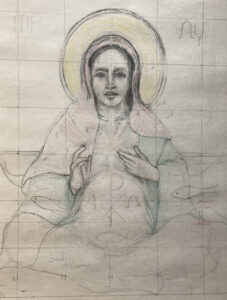
The Feast of Saint Mary the Virgin
The very title of our Feast Day is a stumbling block for many.
The Nicene Creed is a stumbling block for many. In it, as the community’s witness, we state our belief that Jesus was made incarnate from the Holy Spirit and the Virgin Mary, and was made “human.”
Nearly every time I have an honest and open conversation with someone who attends church or has stopped attending, there is a reference to their struggle with the virgin Mary: the idea that anyone could become pregnant by the Holy Spirit without a man being involved. People don’t bring up the verses of descending to hell or rising from the dead. Those concepts seem to have been absorbed and integrated into a framework that is consistent with metaphors for brokenness, death and grief, healing, new birth, transformation.
The Virgin Mary however is a sticking point. So I want to break it open a bit. The Virgin Mary is a designation that only two of our Gospel writers use: Matthew and Luke.
Paul’s letters to the early church which predate the Gospels make no mention of this idea. And Mark our earliest Gospel and the Gospel of John do not use it – nor convey that it is a necessary part of the good news.
Jesus is the miracle (not necessarily because he came out of a virgin).
We have been reading the Gospel of John, and for weeks we have been talking about Jesus as the bread of heaven. We know this is a metaphor. Scripture says Jesus is a shepherd, the light, the vine, the gate. The Kingdom is like a woman making bread. The Kingdom is a tiny seed. God is a potter, a rock, a sun, a shield. God is the Father.
These ideas are designed to convey meaning. The literary device of virgin in this narrative ensures that we get the point that Jesus is a gift of the divine spark of creation. And that’s a miracle!
So much of what is trying to be conveyed by making God “the father” is that we have a relationship initiated through a mystery that is pregnant with affection, with intimacy, with a creator that we can feel bound to – and love. And we are made in that image.
The message is that we are here to mirror God the Creator, the mysterious force and Spirit that calls us into existence.
As humans we strive to find some reconciliation between our fragile human lives and this immense mystery of existence; of the creation and creator of all things.
And the response to this query in the form of Jesus is a miracle. We believe to become fully human, to grow in wisdom into this wild predicament and gift called life, is to grow in love, to heal others, to embrace others, to identify with the suffering; to work to repair the world.
That is the miracle.
Jesus is the miracle; In Greek: the anthropos. He is the fully human being who shows us the way: a “whole” being; Wholly integrated, and that is holy.
We, then, trying to strive to be fully alive and integrated to grow into the full stature of Christ, to know that we carry the divine spark within us…this is also the miracle.
So this great story (I think the greatest story ever told) is not about whether Mary was a virgin.
Mary’s song begins with “My Soul Magnifies the Lord.”
She does not say my body – or my womb magnifies the Lord.
“My soul magnifies the Lord.” The story is about Mary’s choice to help bring God into the World which is Love incarnate as embodied in healing, forgiveness and welcome.
Mary, the God Bearer chooses to be the nurturing container for that love even knowing that her heart will break in that agreement, as it does with any of us; any person who attempts to hold a container of love for others. But being broken open is what allows us to learn to heal and to become fully integrated, fully human to do the work that we have been given to do: to repair the world.
There is a God Bearer in all of us.
As Meister Eckhart said, “We are all meant to be mothers of God for God is always needing to be born.”
Image: Sketch Heather K. Sisk
